MAZDA MODEL CX-5 2017 Owner's Manual - RHD (UK, Australia) (in English)
Manufacturer: MAZDA, Model Year: 2017, Model line: MODEL CX-5, Model: MAZDA MODEL CX-5 2017Pages: 772, PDF Size: 19.35 MB
Page 371 of 772
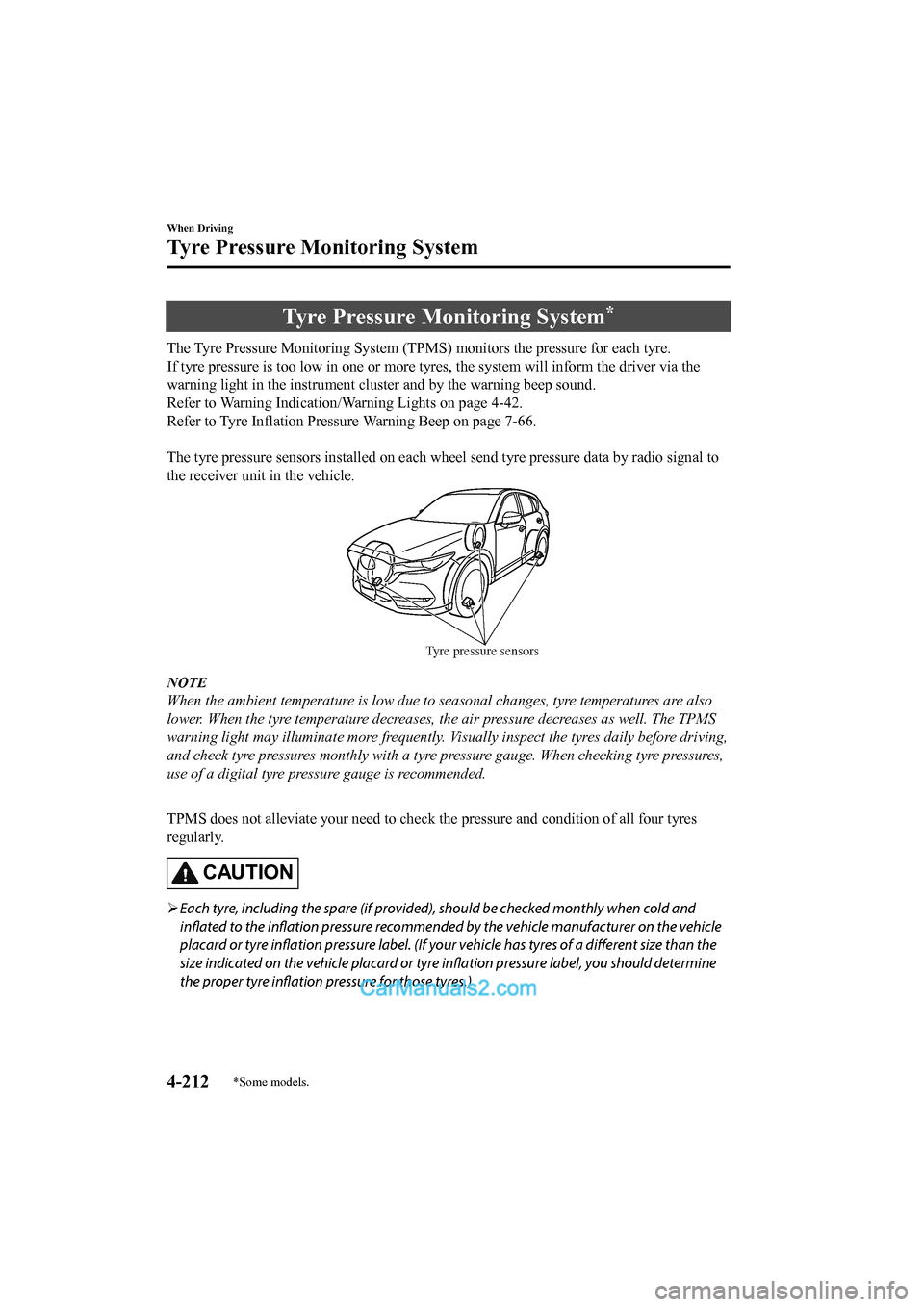
Tyre Pressure Monitoring System*
The Tyre Pressure Monitoring System (TPMS) monitors the pressure for each tyre.
If tyre pressure is too low in one or more tyres, the system wi ll inform the driver via the
warning light in the instrument cluster and by the warning beep sound.
Refer to Warning Indication/Warning Lights on page 4-42.
Refer to Tyre Inflation Pressu re Warning Beep on page 7-66.
The tyre pressure sensors installed on each wheel send tyre pressure data by radio signal to
the receiver unit in the vehicle.
Tyre pressure sensors
NOTE
When the ambient temperature is low due to seasonal changes, tyre temperatures are also
lower. When the tyre temperature decreases, the air pressure decreases as well. The TPMS
warning light may illumina te more frequently. Visually inspect the tyres daily before driving,
and check tyre pressures monthly with a tyre pressure gauge. When checking tyre pressures,
use of a digital tyre pressure gauge is recommended.
TPMS does not alleviate your need to check the pressure and con dition of all four tyres
regularly.
CAUTION
Each tyre, including the spare (if provided), should be checked monthly when cold and
inflated to the inflation pressure recommended by the vehicle manufacturer on the vehicle
placard or tyre inflation pressure label. (If your vehicle has tyres of a different size than the
size indicated on the vehicle placard or tyre inflation pressure label, you should determine
the proper tyre inflation pressure for those tyres.)
When Driving
Tyre Pressure Monitoring System
4-212*Some models.
2017-6-7 7:51:19 Form No. CX-5 8FY4-EE-17E+L_Edition2
Page 372 of 772
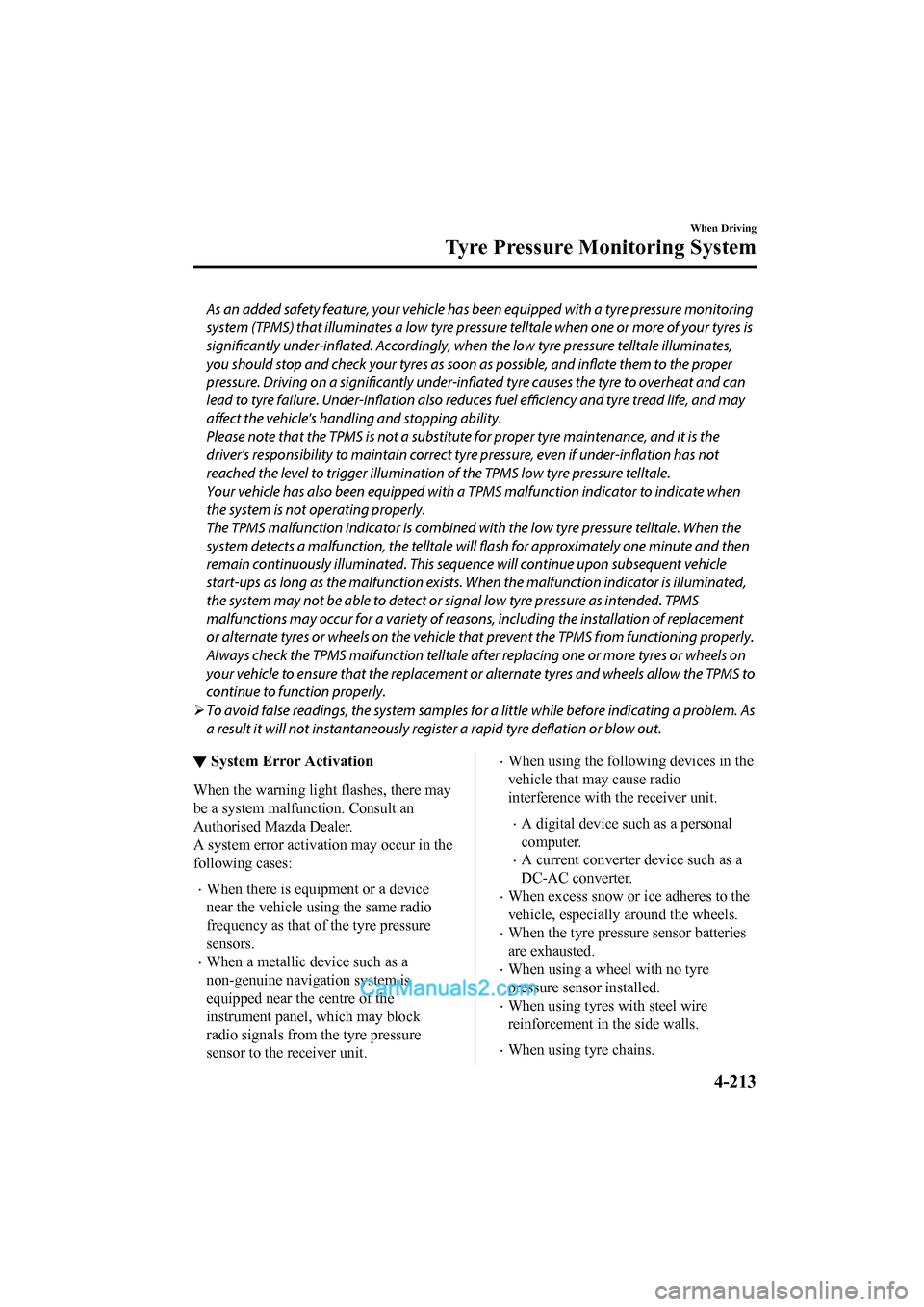
As an added safety feature, your vehicle has been equipped with a tyre pressure monitoring
system (TPMS) that illuminates a low tyre pressu re telltale when one or more of your tyres is
significantly under-inflated. Accordingly, wh en the low tyre pressure telltale illuminates,
you should stop and check your tyres as soon as possible, and inflate them to the proper
pressure. Driving on a significantly under-infla ted tyre causes the tyre to overheat and can
lead to tyre failure. Under-inflation also reduc es fuel efficiency and tyre tread life, and may
affect the vehicle's handling and stopping ability.
Please note that the TPMS is not a substitute for proper tyre maintenance, and it is the
driver's responsibility to maintain correct ty re pressure, even if under-inflation has not
reached the level to trigger illumination of the TPMS low tyre pressure telltale.
Your vehicle has also been equipped with a TPMS malfunction indicator to indicate when
the system is not operating properly.
The TPMS malfunction indicator is combined with the low tyre pressure telltale. When the
system detects a malfunction, the telltale wi ll flash for approximately one minute and then
remain continuously illuminated. This sequence will continue upon subsequent vehicle
start-ups as long as the malfunction exists. When the malfunction indicator is illuminated,
the system may not be able to detect or signal low tyre pressure as intended. TPMS
malfunctions may occur for a variety of reasons, including the installation of replacement
or alternate tyres or wheels on the vehicle th at prevent the TPMS from functioning properly.
Always check the TPMS malfunction telltale af ter replacing one or more tyres or wheels on
your vehicle to ensure that the replacement or alternate tyres and wheels allow the TPMS to
continue to function properly.
To avoid false readings, the system samples for a little while before indicating a problem. As
a result it will not instantaneously regi ster a rapid tyre deflation or blow out.
▼System Error Activation
When the warning light flashes, there may
be a system malfunction. Consult an
Authorised Mazda Dealer.
A system error activation may occur in the
following cases:
•When there is equipment or a device
near the vehicle using the same radio
frequency as that of the tyre pressure
sensors.
•When a metallic device such as a
non-genuine navigation system is
equipped near the centre of the
instrument panel, which may block
radio signals from the tyre pressure
sensor to the receiver unit.
•When using the following devices in the
vehicle that may cause radio
interference with the receiver unit.
•A digital device such as a personal
computer.
•A current converter device such as a
DC-AC converter.
•When excess snow or ice adheres to the
vehicle, especially around the wheels.
•When the tyre pressure sensor batteries
are exhausted.
•When using a wheel with no tyre
pressure sensor installed.
•When using tyres with steel wire
reinforcement in the side walls.
•When using tyre chains.
When Driving
Tyre Pressure Monitoring System
4-213
2017-6-7 7:51:19 Form No. CX-5 8FY4-EE-17E+L_Edition2
Page 373 of 772
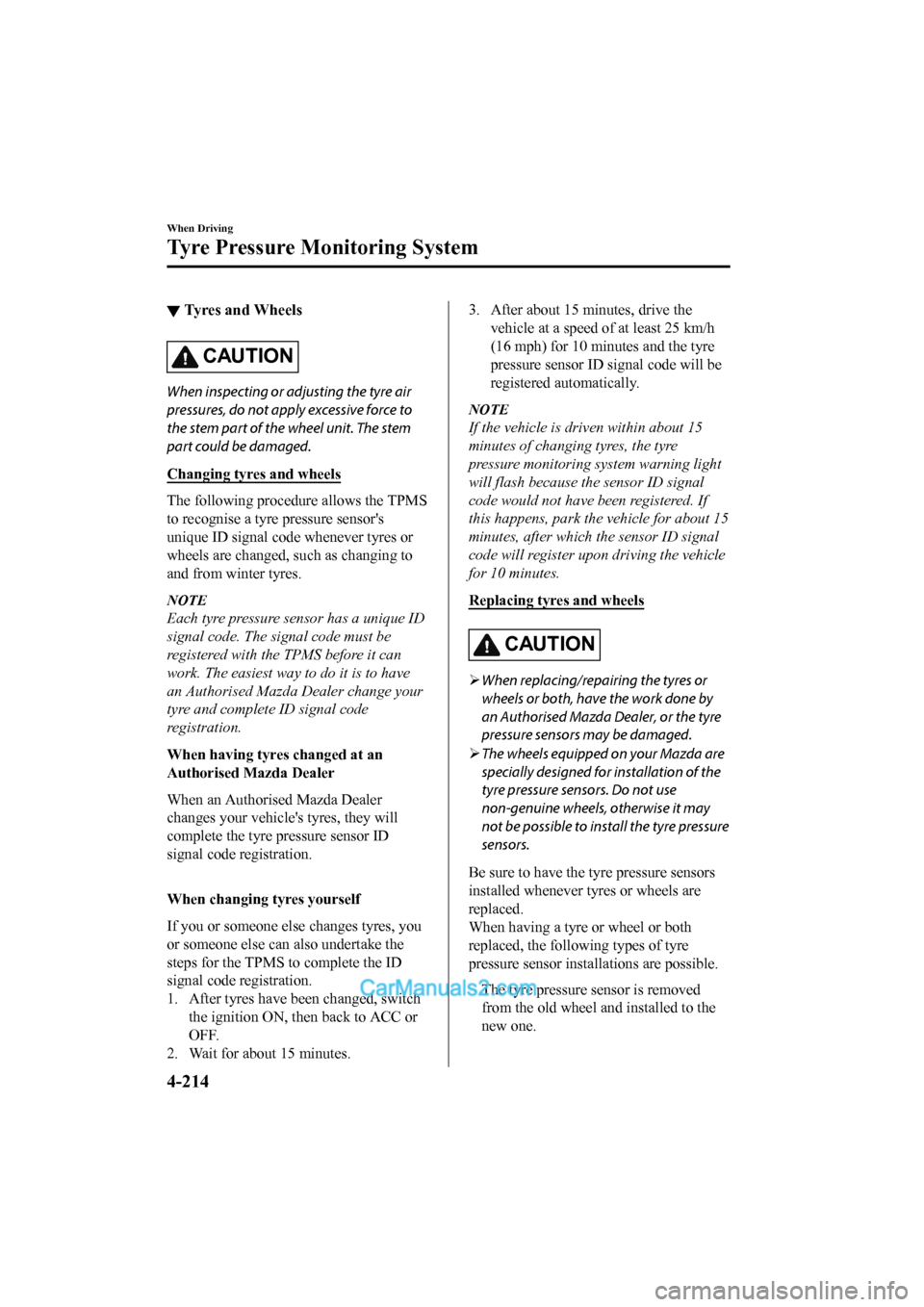
▼Tyres and Wheels
CAUTION
When inspecting or adjusting the tyre air
pressures, do not apply excessive force to
the stem part of the wheel unit. The stem
part could be damaged.
Changing tyres and wheels
The following procedure allows the TPMS
to recognise a tyre pressure sensor's
unique ID signal code whenever tyres or
wheels are changed, such as changing to
and from winter tyres.
NOTE
Each tyre pressure sensor has a unique ID
signal code. The signal code must be
registered with the TPMS before it can
work. The easiest way to do it is to have
an Authorised Mazda Dealer change your
tyre and complete ID signal code
registration.
When having tyres changed at an
Authorised Mazda Dealer
When an Authorised Mazda Dealer
changes your vehicle's tyres, they will
complete the tyre pressure sensor ID
signal code registration.
When changing
tyres yourself
If you or someone else changes tyres, you
or someone else can also undertake the
steps for the TPMS t o complete the ID
signal code registration.
1. After tyres have been changed, switch
the ignition ON, then back to ACC or
OFF.
2. Wait for about 15 minutes.
3. After about 15 minutes, drive the vehicle at a speed of at least 25 km/h
(16 mph) for 10 minutes and the tyre
pressure sensor ID s ignal code will be
registered automatically.
NOTE
If the vehicle is driven within about 15
minutes of changing tyres, the tyre
pressure monitoring system warning light
will flash because the sensor ID signal
code would not have been registered. If
this happens, park the vehicle for about 15
minutes, after which the sensor ID signal
code will register upon driving the vehicle
for 10 minutes.
Replacing tyres and wheels
CAUTION
When replacing/repairing the tyres or
wheels or both, have the work done by
an Authorised Mazda Dealer, or the tyre
pressure sensors may be damaged.
The wheels equipped on your Mazda are
specially designed for installation of the
tyre pressure sensors. Do not use
non-genuine wheels, otherwise it may
not be possible to install the tyre pressure
sensors.
Be sure to have the ty re pressure sensors
installed whenever tyres or wheels are
replaced.
When having a tyre or wheel or both
replaced, the follow ing types of tyre
pressure sensor installations are possible.
•The tyre pressure sensor is removed
from the old wheel and installed to the
new one.
When Driving
Tyre Pressure Monitoring System
4-214
2017-6-7 7:51:19 Form No. CX-5 8FY4-EE-17E+L_Edition2
Page 374 of 772
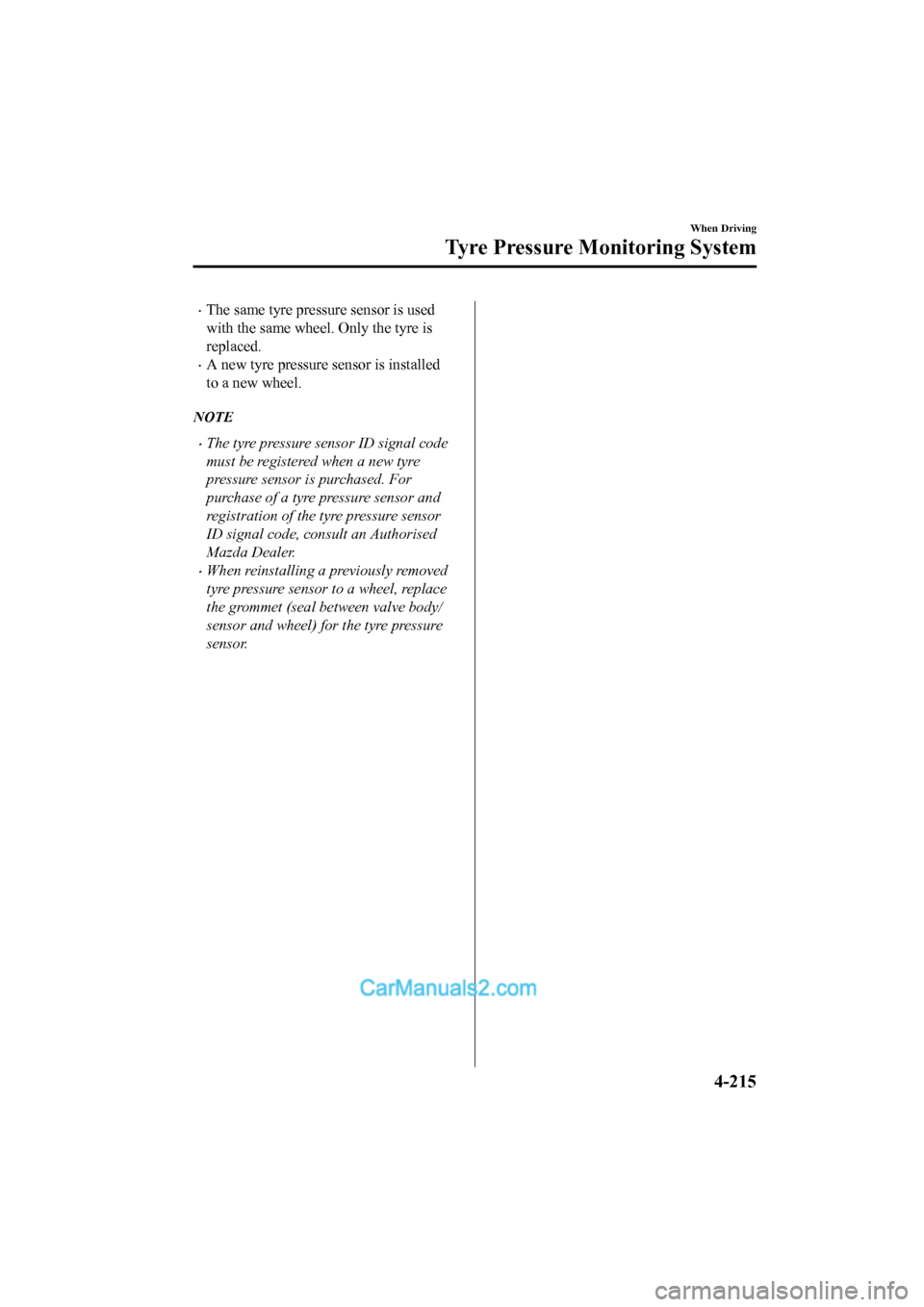
•The same tyre pressure sensor is used
with the same wheel. Only the tyre is
replaced.
•A new tyre pressure s ensor is installed
to a new wheel.
NOTE
•The tyre pressure sensor ID signal code
must be registered when a new tyre
pressure sensor is purchased. For
purchase of a tyre pressure sensor and
registration of the tyre pressure sensor
ID signal code, consult an Authorised
Mazda Dealer.
•When reinstalling a previously removed
tyre pressure sensor to a wheel, replace
the grommet (seal between valve body/
sensor and wheel) for the tyre pressure
sensor.
When Driving
Tyre Pressure Monitoring System
4-215
2017-6-7 7:51:19 Form No. CX-5 8FY4-EE-17E+L_Edition2
Page 375 of 772
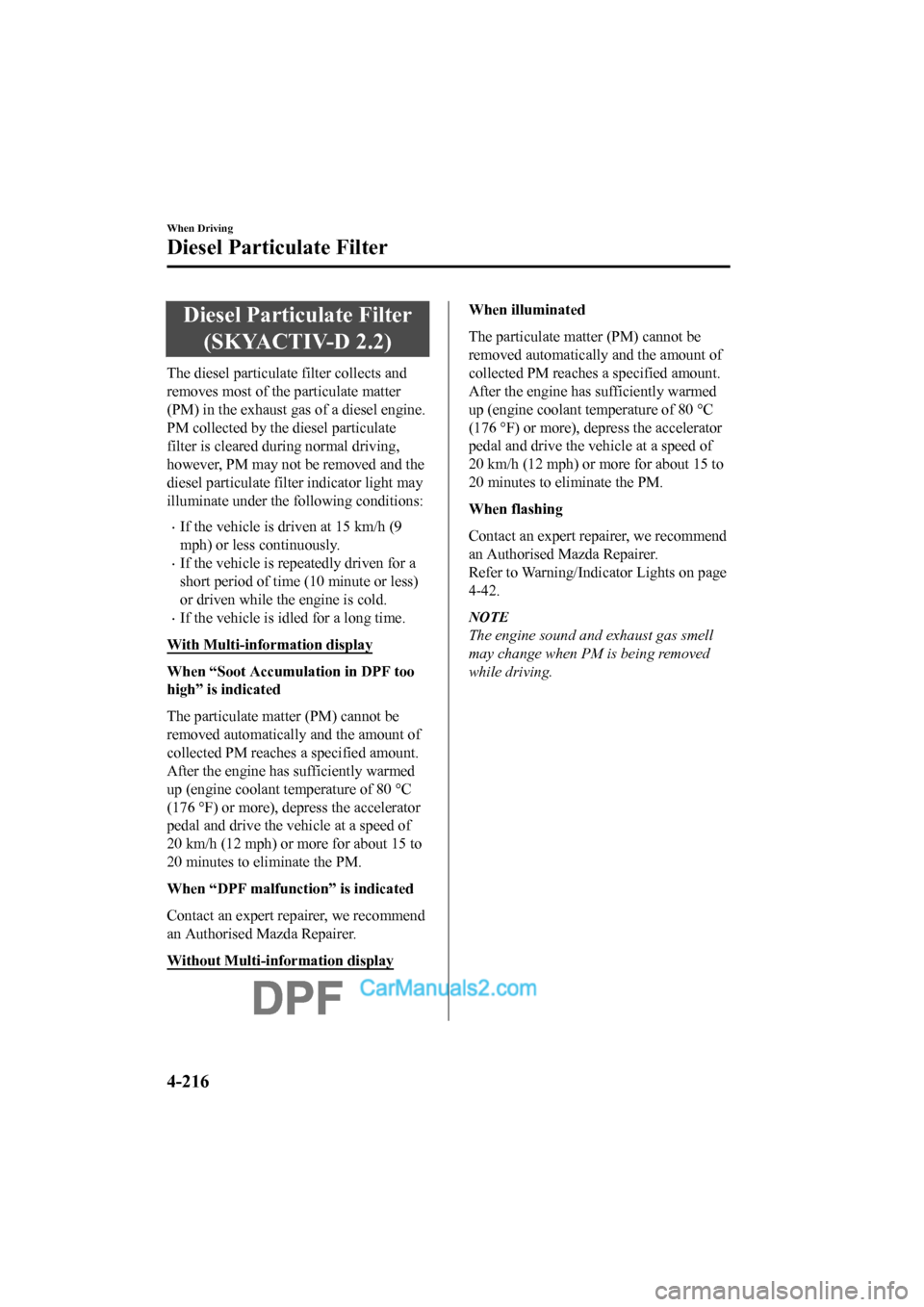
Diesel Particulate Filter(SKYACTIV-D 2.2)
The diesel particulate filter collects and
removes most of the particulate matter
(PM) in the exhaust gas of a diesel engine.
PM collected by the diesel particulate
filter is cleared during normal driving,
however, PM may not be removed and the
diesel particulate filter indicator light may
illuminate under the following conditions:
•If the vehicle is driven at 15 km/h (9
mph) or less continuously.
•If the vehicle is repeatedly driven for a
short period of time (10 minute or less)
or driven while the engine is cold.
•If the vehicle is idled for a long time.
With Multi-inform ation display
When “Soot Accumulation in DPF too
high” is indicated
The particulate matter (PM) cannot be
removed automatically and the amount of
collected PM reaches a specified amount.
After the engine has sufficiently warmed
up (engine coolant temperature of 80 °C
(176 °F) or more), depress the accelerator
pedal and drive the vehicle at a speed of
20 km/h (12 mph) or more for about 15 to
20 minutes to eliminate the PM.
When “DPF malfunction” is indicated
Contact an expert repairer, we recommend
an Authorised Mazda Repairer.
Without Multi-information display
When illuminated
The particulate matter (PM) cannot be
removed automatically and the amount of
collected PM reaches a specified amount.
After the engine has sufficiently warmed
up (engine coolant temperature of 80 °C
(176 °F) or more), d epress the accelerator
pedal and drive the vehicle at a speed of
20 km/h (12 mph) or more for about 15 to
20 minutes to eliminate the PM.
When flashing
Contact an expert repairer, we recommend
an Authorised Mazda Repairer.
Refer to Warning/Indicator Lights on page
4-42.
NOTE
The engine sound and exhaust gas smell
may change when PM is being removed
while driving.
When Driving
Diesel Particulate Filter
4-216
2017-6-7 7:51:19 Form No. CX-5 8FY4-EE-17E+L_Edition2
Page 376 of 772
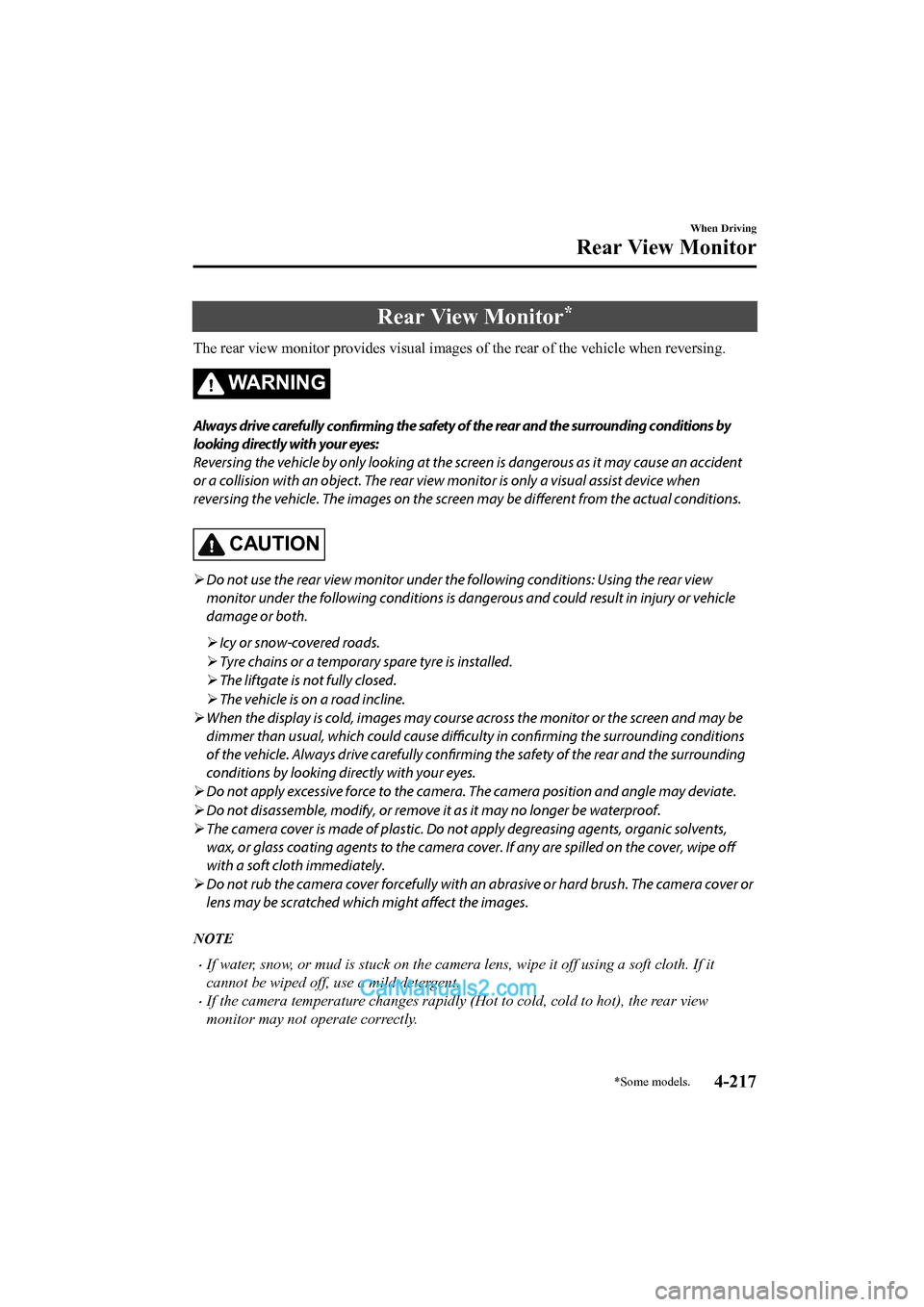
Rear View Monitor*
The rear view monitor provides visual images of the rear of the vehicle when reversing.
WA R N I N G
Always drive carefully
confirming the safety of the rear and the surrounding conditions by
looking directly with your eyes:
Reversing the vehicle by only looking at the screen is dangerous as it may cause an accident
or a collision with an object. The rear view monitor is only a visual assist device when
reversing the vehicle. The images on the scree n may be different from the actual conditions.
CAUTION
Do not use the rear view monitor under th e following conditions: Using the rear view
monitor under the following conditions is dang erous and could result in injury or vehicle
damage or both.
Icy or snow-covered roads.
Tyre chains or a temporary spare tyre is installed.
The liftgate is not fully closed.
The vehicle is on a road incline.
When the display is cold, images may course across the monitor or the screen and may be
dimmer than usual, which could cause difficulty in confirming the surrounding conditions
of the vehicle. Always drive carefully confirm ing the safety of the rear and the surrounding
conditions by looking directly with your eyes.
Do not apply excessive force to the camera. The camera position and angle may deviate.
Do not disassemble, modify, or remove it as it may no longer be waterproof.
The camera cover is made of plastic. Do no t apply degreasing agents, organic solvents,
wax, or glass coating agents to the camera co ver. If any are spilled on the cover, wipe off
with a soft cloth immediately.
Do not rub the camera cover forcefully with an abrasive or hard brush. The camera cover or
lens may be scratched which might affect the images.
NOTE
•If water, snow, or mud is stuck on the camera lens, wipe it off using a soft cloth. If it
cannot be wiped off, use a mild detergent.
•If the camera temperature changes rapidly (Hot to cold, cold to hot), the rear view
monitor may not operate correctly.
When Driving
Rear View Monitor
*Some models.4-217
2017-6-7 7:51:19 Form No. CX-5 8FY4-EE-17E+L_Edition2
Page 377 of 772
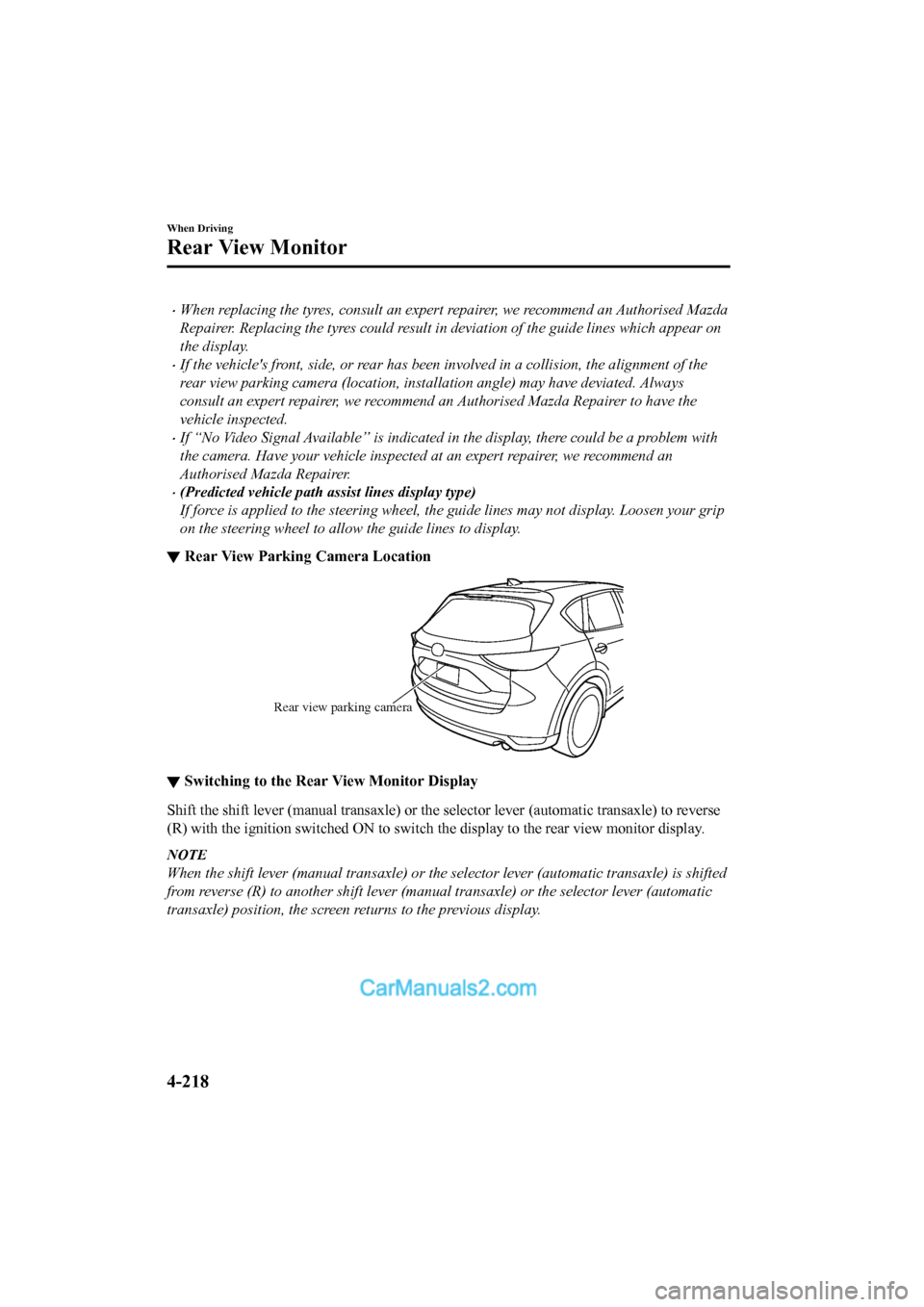
•When replacing the tyres, consult an expert repairer, we recommend an Authorised Mazda
Repairer. Replacing the tyres could result in deviation of the guide lines which appear on
the display.
•If the vehicle's front, side, or rear has been involved in a collision, the alignment of the
rear view parking camera (location, installation angle) may have deviated. Always
consult an expert repairer, we recommend an Authorised Mazda Repairer to have the
vehicle inspected.
•If “No Video Signal Available” is indicated in the display, there could be a problem with
the camera. Have your vehicle inspected at an expert repairer, we recommend an
Authorised Mazda Repairer.
•(Predicted vehicle path assist lines display type)
If force is applied to the steering wheel, the guide lines may not display. Loosen your grip
on the steering wheel to allow the guide lines to display.
▼Rear View Parking Camera Location
Rear view parking camera
▼Switching to the Rear
View Monitor Display
Shift the shift lever (manual transaxle) or the selector lever (automatic transaxle) to reverse
(R) with the ignition switched ON to switch the display to the rear view monitor display.
NOTE
When the shift lever (manual transaxle) or the selector lever (automatic transaxle) is shifted
from reverse (R) to another shift lever (manual transaxle) or the selector lever (automatic
transaxle) position, the screen returns to the previous display.
When Driving
Rear View Monitor
4-218
2017-6-7 7:51:19 Form No. CX-5 8FY4-EE-17E+L_Edition2
Page 378 of 772
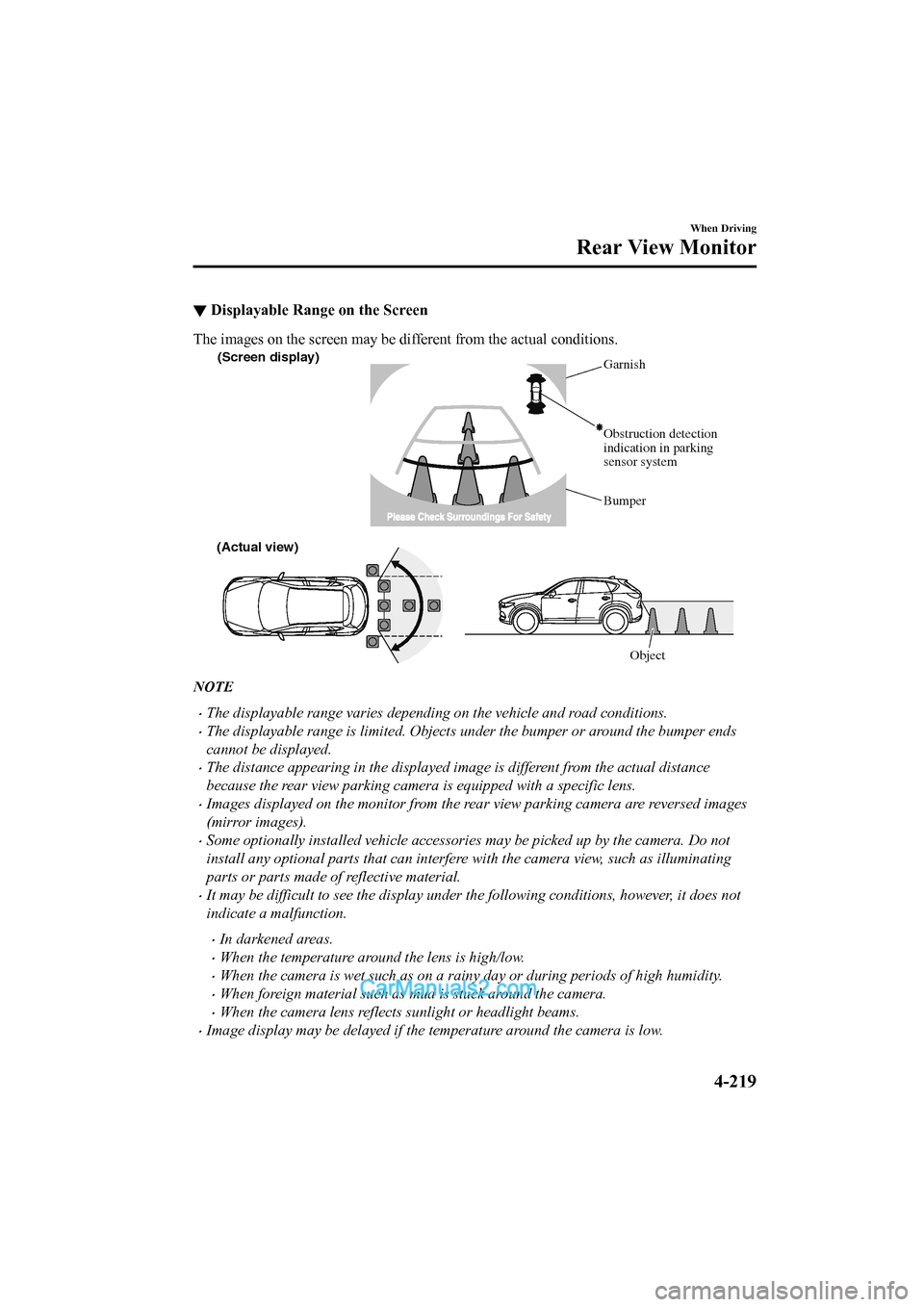
▼Displayable Range on the Screen
The images on the screen may be different from the actual conditions.
(Screen display)
Garnish
Bumper
(Actual view)
Object
Obstruction detection
indication in parking
sensor system
NOTE
•The displayable range varies depending on the vehicle and road conditions.
•The displayable range is limited. Objects under the bumper or around the bumper ends
cannot be displayed.
•The distance appearing in the displayed image is different from the actual distance
because the rear view parking camera is equipped with a specific lens.
•Images displayed on the monitor from the rear view parking camera are reversed images
(mirror images).
•Some optionally installed vehicle accessories may be picked up by the camera. Do not
install any optional parts that can interfere with the camera view, such as illuminating
parts or parts made of reflective material.
•It may be difficult to see the display under the following conditions, however, it does not
indicate a malfunction.
•In darkened areas.
•When the temperature around the lens is high/low.
•When the camera is wet such as on a rainy day or during periods of high humidity.
•When foreign material such as mud is stuck around the camera.
•When the camera lens reflects sunlight or headlight beams.
•Image display may be delayed if the temperature around the camera is low.
When Driving
Rear View Monitor
4-219
2017-6-7 7:51:19Form No. CX-5 8FY4-EE-17E+L_Edition2
Page 379 of 772
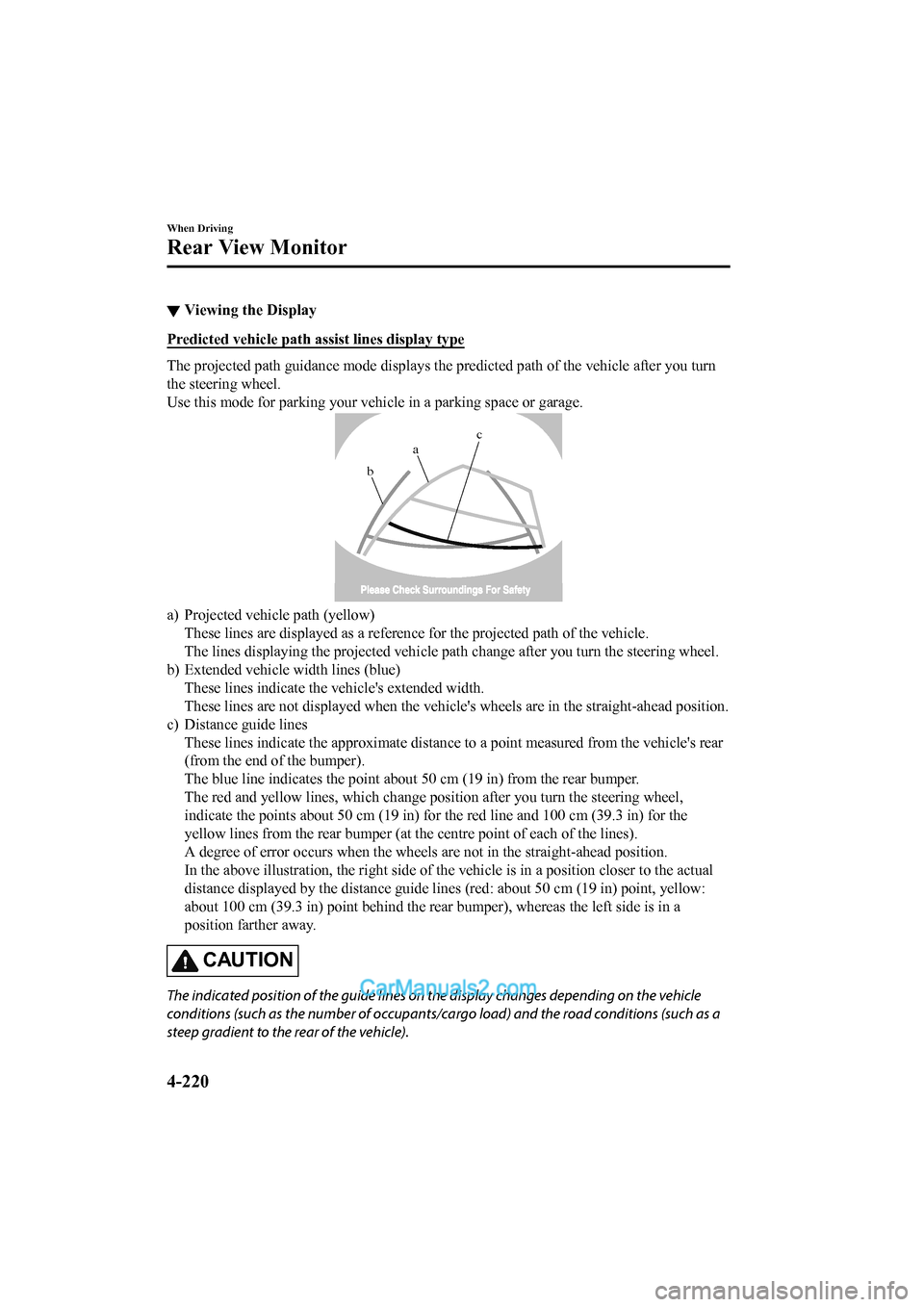
▼Viewing the Display
Predicted vehicle path a
ssist lines display type
The projected path guidance mode displays the predicted path of the vehicle after you turn
the steering wheel.
Use this mode for parking your vehicle in a parking space or ga rage.
ba
c
a) Projected vehicle path (yellow)
These lines are displayed as a reference for the projected path of the vehicle.
The lines displaying the projected vehicle path change after yo u turn the steering wheel.
b) Extended vehicle width lines (blue)
These lines indicate the vehicle's extended width.
These lines are not displayed when the vehicle's wheels are in the straight-ahead position.
c) Distance guide lines These lines indicate the approximate distance to a point measur ed from the vehicle's rear
(from the end of the bumper).
The blue line indicates the poi nt about 50 cm (19 in) from the rear bumper.
The red and yellow lines, which change position after you turn the steering wheel,
indicate the points about 50 cm (19 in) for the red line and 10 0 cm (39.3 in) for the
yellow lines from the rear bumper (at the centre point of each of the lines).
A degree of error occurs when the wheels are not in the straigh t-ahead position.
In the above illustration, the ri ght side of the vehicle is in a position closer to the actual
distance displayed by the distance guide lines (red: about 50 c m (19 in) point, yellow:
about 100 cm (39.3 in) point behind the rear bumper), whereas t he left side is in a
position farther away.
CAUTION
The indicated position of the guide lines on the display changes depending on the vehicle
conditions (such as the number of occupants/ca rgo load) and the road conditions (such as a
steep gradient to the rear of the vehicle).
When Driving
Rear View Monitor
4-220
2017-6-7 7:51:19 Form No. CX-5 8FY4-EE-17E+L_Edition2
Page 380 of 772
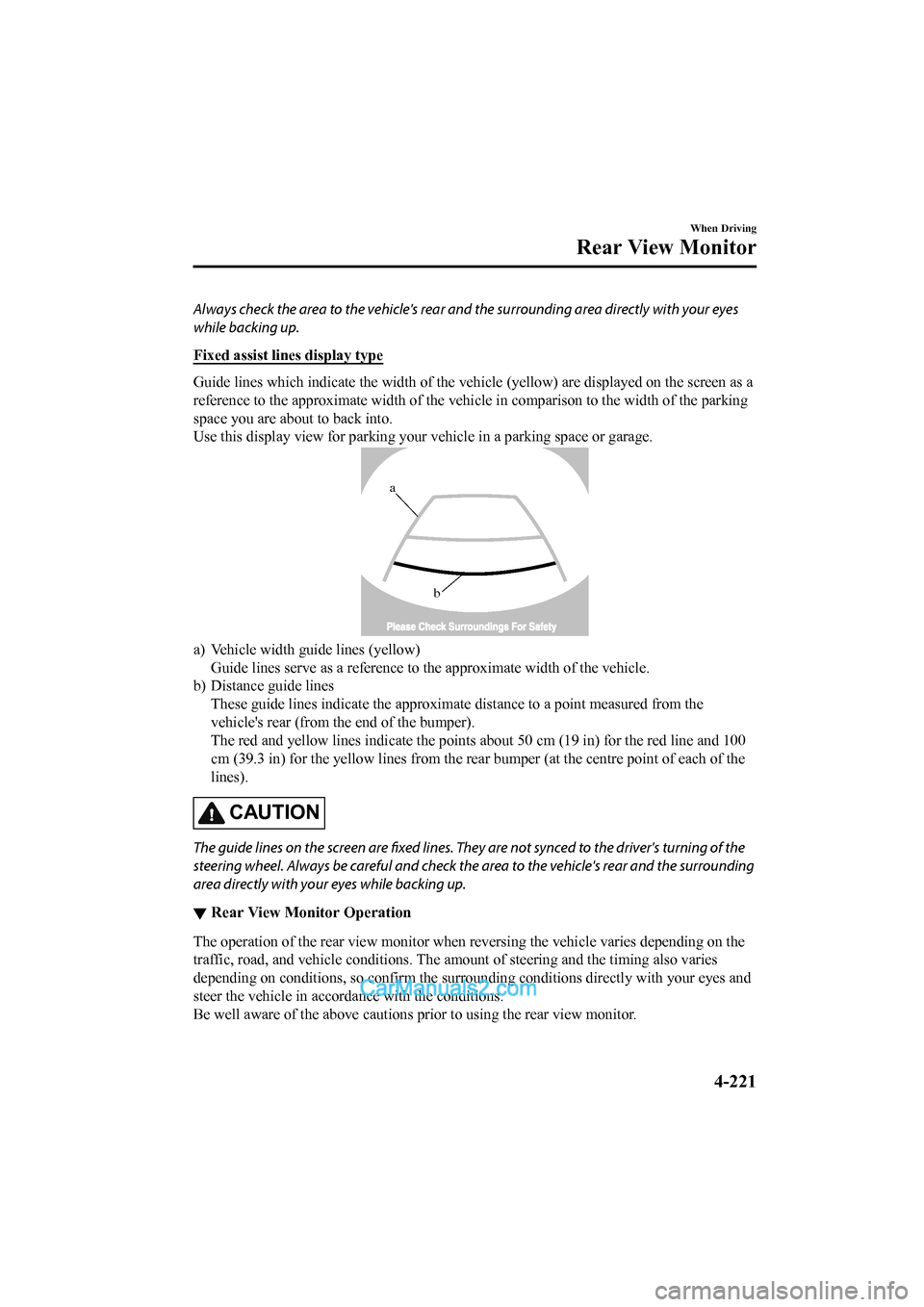
Always check the area to the vehicle's rear and the surrounding area directly with your eyes
while backing up.
Fixed assist lines display type
Guide lines which indicate the wid th of the vehicle (yellow) are displayed on the screen as a
reference to the approximate width of the vehicle in comparison to the width of the parking
space you are about to back into.
Use this display view for parking your vehicle in a parking spa ce or garage.
b
a
a) Vehicle width guide lines (yellow)
Guide lines serve as a reference to the approximate width of th e vehicle.
b) Distance guide lines
These guide lines indicate the approximate distance to a point measured from the
vehicle's rear (from the end of the bumper).
The red and yellow lines indicate the points about 50 cm (19 in ) for the red line and 100
cm (39.3 in) for the yellow lines from the rear bumper (at the centre point of each of the
lines).
CAUTION
The guide lines on the screen are fixed lines. They are not synced to the driver's turning of the
steering wheel. Always be careful and check the area to the vehicle's rear and the surrounding
area directly with your eyes while backing up.
▼ Rear View Monitor Operation
The operation of the rear view monitor when reversing the vehic
le varies depending on the
traffic, road, and vehicle conditions. The amount of steering a nd the timing also varies
depending on conditions, so conf irm the surrounding conditions directly with your eyes and
steer the vehicle in accordance with the conditions.
Be well aware of the above cautions prior to using the rear vie w monitor.
When Driving
Rear View Monitor
4-221
2017-6-7 7:51:19 Form No. CX-5 8FY4-EE-17E+L_Edition2